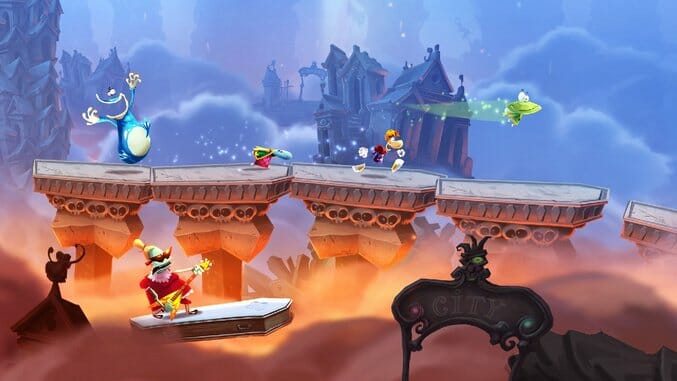Rayman Legends (Multi-Platform)

There’s much to consider when designing a 2D platformer. How many pixels can a character span in a single jump? How fast does a character move? How about the level architecture, and the placement and motion of enemies, and the number of hits needed to kill them? These are all crucial decisions that many players take for granted as they sprint through a game.
One of the most common elements of a side-scrolling platformer is a sense of play. Not the sense of actually playing the game, but the kind of light-hearted frivolity baked into the genre from its earliest days. Think the psychedelic whimsy of a Mario game, or the exaggerated attitude of Sonic. When gritty games about guns and the musclemen who tote them largely absconded to the third dimension, playfulness rose from the dominant tone of platformers to practically the only tone found in the genre. The only sidescrolling platformers made today are fantastical, family-friendly romps or pedantic indie exercises, and among the former few games are more fantastical or playful than Rayman Legends.
Rayman Legends expands upon 2011’s excellent Rayman Origins, offering up the same charm and classic platforming challenge in a more elaborate package. It feels like a playable cartoon, with gorgeous environments that are warm and surreal, and a sly and kinetic sense of humor. It’s an interactive cousin to Looney Tunes inspired less by vaudeville than European clowning, with Rayman (and thus the player) in the role of the irreverent Auguste clown, undermining the self-imposed rules of the designers as if they were the would-be sophisticates of the whiteface clown. Rayman Legends is made in France, and it shows—it’s familiar but foreign, classy but vaguely vulgar, and very European. Think of Rayman as Mario’s French exchange student.
Rayman Legends experiments with variations on the standard side-scrolling platformer across its dozens of levels. Most are traditional in design, with Rayman free to explore wooded areas or caves while punching enemies, dodging obstacles, rescuing Teensies (the game world’s put-upon inhabitants) and searching for Lums (smiling little suns with wings that are the game’s primary collectibles.) Certain levels force players into speed runs, as walls of flame or unbeatable behemoths charge persistently from the left, leaving Rayman no recourse but to sprint full speed towards the right while pulling off pristine jumps to avoid death. Elsewhere barbarian princesses can be unlocked as playable characters by finishing certain levels that often have minor boss battles, and “invaded” missions revisit previous levels as timed sprints beset by enemies from other worlds.
Legends was designed for the Wii U, and the missions where players control a flying frog named Murfy make that clear. These levels are confusing on the 360 or PlayStation 3, where one has to control both Murfy and Rayman with a controller at the same time. The Wii U GamePad turns these stretches of the game into tablet-style touchscreen auto-runners, although instead of controlling the runner the player controls the environment. Ropes are slashed to make spiked walls drop out of the way, and wheels are twisted to clear a safe path through elaborate deathtraps. These levels are solid mechanically but lack the speed and direct response that make the traditional levels so thrilling. This control scheme smartly exploits the GamePad’s peculiar capabilities in a way that most Wii U games haven’t so far, but these levels are still brief detours on an otherwise riotous road trip.
